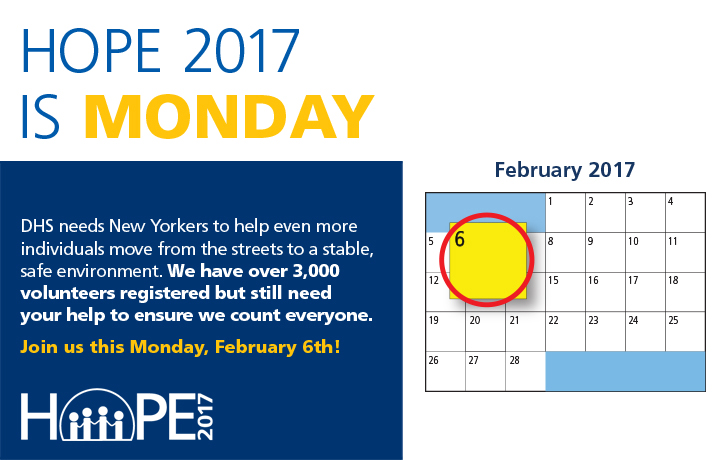
 Department of Homeless Services311
Department of Homeless Services311 Search all NYC.gov websites
Search all NYC.gov websites

FOR PLANNING PURPOSES ONLY
February 3, 2017
Contact: Lauren Gray (grayl@hra.nyc.gov, o: 929-221-5249 c: 917-790-3890)
MEDIA ADVISORY: HOPE COUNT VOLUNTEER TRAINING
NEW YORK—On Monday, February 6, 2017, Department of Social Services Commissioner Steven Banks will kick-off a HOPE Count volunteer training session at PS 116 in Manhattan with Deputy Mayor for Health and Human Services Herminia Palacio. This event will be open press.
Following the volunteer training kick-off, the Commissioner will go out and review one of the survey routes in advance of the count. This will also be open press. Members of the media may remain at the school to observe the remainder of the training, including volunteers leaving to start the HOPE count. As of Friday, February 3, more than 3,500 individuals have volunteered to participate.
In order to protect the privacy of homeless individuals on our streets and ensure a more accurate count, there will be no media tours during the actual count between 12 AM and 4 AM. Members of the media interested in participating in the count are encouraged to volunteer for the entire four-hour count. Cameras are not allowed to accompany volunteers.
Sign up to volunteer for the HOPE count at nyc.gov/hope
When: Monday, February 6, 2017 – 10:30 PM
Where: PS 116, 210 East 33rd Street, New York, NY 10016
Who:
- Deputy Mayor for Health and Human Services Herminia Palacio
- Department of Social Services Commissioner Steven Banks
- Elected officials
About the HOPE Count:
The Homeless Outreach Population Estimate (HOPE), conducted by the NYC Department of Homeless Services, is an annual, HUD-mandated, point-in-time estimate to assess the number of individuals living in New York City’s public spaces. On the night of the HOPE Count, thousands of volunteers are assembled and sent out in teams to survey New York’s streets, subways and parks. The estimate produced by this survey is used to project service needs, allocate resources for the street homeless population, and educate and engage fellow New Yorkers about this serious issue for all communities.


